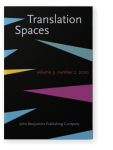Vol. 9:2 (2020) ► pp.283–313
Language industry views on the profile of the post-editor
The more language service companies (LSCs) include machine translation post-editing (MTPE) in their workflows, the more important it is to know how the PE task is performed, who the post-editors are, and what skills they should have. This research is designed to address such questions. It aims to deepen our knowledge of current practices to later create new training content and adapt existing training methodologies to different types of audiences. Based on the results of a survey of LSCs and other companies who currently use MTPE, we present a picture of evolving practices in the contemporary European MTPE market, and opinions held about this emerging métier. Our research finds that a high level of expertise in MTPE may not necessarily be indicative of the industry, and that the post-editor of MT has a multi- and transdisciplinary profile.
Article outline
- 1.Introduction
- 2.Survey methodology
- 2.1Questionnaire design
- 2.2Profile of the respondents
- 3.The questionnaire’s core topics
- 4.Analysis and interpretation of results
- 4.1PE tasks
- 4.2PE hiring criteria
- 4.3PE skills
- 4.4MTPE training content
- 5.Conclusion
- Acknowledgements
- Notes
-
References
